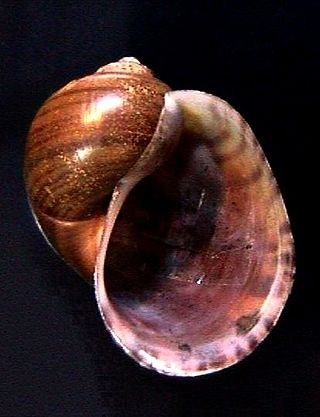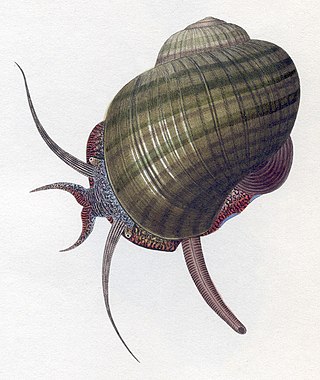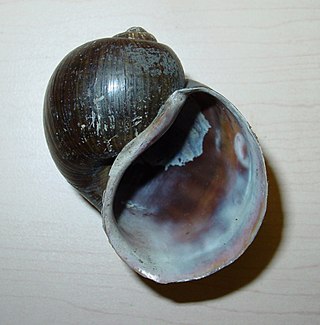Related Research Articles

Ampullariidae, whose members are commonly known as apple snails, is a family of large freshwater snails that includes the mystery snail species. They are aquatic gastropod mollusks with a gill and an operculum. These snails simultaneously have a gill and a lung as functional respiratory structures, which are separated by a division of the mantle cavity. This adaptation allows these animals to be amphibious. Species in this family are considered gonochoristic, meaning that each individual organism is either male or female.
A trypsin inhibitor (TI) is a protein and a type of serine protease inhibitor (serpin) that reduces the biological activity of trypsin by controlling the activation and catalytic reactions of proteins. Trypsin is an enzyme involved in the breakdown of many different proteins, primarily as part of digestion in humans and other animals such as monogastrics and young ruminants. Serpins – including trypsin inhibitors – are irreversible and suicide substrate-like inhibitors.

Pila is a genus of large freshwater snails with an operculum, African and Asian apple snails, aquatic gastropod mollusks in the family Ampullariidae, the apple snails.
Pila ampullacea, is a species of freshwater snail with an operculum, an aquatic gastropod mollusk in the family Ampullariidae, the apple snails.

Pomacea is a genus of freshwater snails with gills and an operculum, aquatic gastropod mollusks in the family Ampullariidae, the apple snails. The genus is native to the Americas; most species in this genus are restricted to South America.

Pomacea canaliculata, commonly known as the golden apple snail or the channeled apple snail, is a species of large freshwater snail with gills and an operculum, an aquatic gastropod mollusc in the family Ampullariidae, the apple snails. South American in origin, this species is considered to be in the top 100 of the "World's Worst Invasive Alien Species". It is also ranked as the 40th worst alien species in Europe and the worst alien species of gastropod in Europe.

Pomacea haustrum, common name the titan applesnail, is a species of large freshwater snail with an operculum, an aquatic gastropod mollusk in the family Ampullariidae, the applesnails.

Pomacea diffusa, common name the spike-topped apple snail, is a species of freshwater snail, an aquatic gastropod mollusk in the family Ampullariidae, the apple snails.

Pomacea paludosa, common name the Florida applesnail, is a species of freshwater snail with an operculum, an aquatic gastropod mollusk in the family Ampullariidae, the apple snails.

The AB toxins are two-component protein complexes secreted by a number of pathogenic bacteria, though there is a pore-forming AB toxin found in the eggs of a snail. They can be classified as Type III toxins because they interfere with internal cell function. They are named AB toxins due to their components: the "A" component is usually the "active" portion, and the "B" component is usually the "binding" portion. The "A" subunit possesses enzyme activity, and is transferred to the host cell following a conformational change in the membrane-bound transport "B" subunit. These proteins consist of two independent polypeptides, which correspond to the A/B subunit moieties. The enzyme component (A) enters the cell through endosomes produced by the oligomeric binding/translocation protein (B), and prevents actin polymerisation through ADP-ribosylation of monomeric G-actin.

Pomacea maculata is a species of large freshwater snail with an operculum, an aquatic gastropod mollusk in the family Ampullariidae, the apple snails.

Galactogen is a polysaccharide of galactose that functions as energy storage in pulmonate snails and some Caenogastropoda. This polysaccharide is exclusive of the reproduction and is only found in the albumen gland from the female snail reproductive system and in the perivitelline fluid of eggs.
Perivitellins are egg proteins found in the perivitelline fluid of many gastropods. They are multifunctional complexes providing the developing embryo with nutrition, protection from the environment, and defense against predators.
Ovorubin is the most abundant perivitellin of the perivitelline fluid from Pomacea canaliculata snail eggs. This glyco-lipo-caroteno protein complex is a approx. 300 kDa multimer of a combination of multiple copies of six different ~30 kDa subunits.
Pomacea maculata perivitellin-1 (PmPV1) is the most abundant perivitellin found in the perivitelline fluid from Pomacea maculata snail eggs. This glyco-lipo-caroteno protein is an approx. 294 kDa multimer of a combination of multiple copies of six different ~30 kDa subunits. PmPV1 account >60% of the total proteins found in the Pomacea maculata eggs.
Scalarin (PsSC) is the most abundant perivitellin of the perivitelline fluid from Pomacea scalaris eggs. This glyco-lipo-caroteno protein is an approx. 380 kDa multimer combining multiple copies of six different 24-35 kDa subunits.
Perivitellin-2 (PV2) is a pore-forming toxin present in the egg perivitelline fluid of the apple snails Pomacea maculata (PmPV2) and Pomacea canaliculata (PcPV2). This protein, called perivitellin, is massively accumulated in the eggs. As a toxin PV2 protects eggs from predators, but it also nourishes the developing snail embryos.

Pomacea columellaris is a South American species of freshwater snail in the apple snail family, Ampullariidae.

Pomacea fasciata is a freshwater snail in the Ampullariidae family. It is located in Jamaica, Guadeloupe, and Hispaniola. It lays white eggs.
Temptin is a protein that acts as a water-borne pheromone in the marine gastropod mollusk Aplysia californica. It is an abundant protein that is synthesized in the albumen gland, and is released in the egg cords during oviposition, along with other proteins called attractin, seductin and enticin. Together, they make up a complex of water-soluble proteins that act together to attract mates for reproduction and induce spawning.
References
- 1 2 3 4 De Jong-Brink M, Boer HH, Joose J (1983). "Mollusca". In Adiyodi KG, Adiyodi RG (eds.). Reproductive Biology of Invertebrates. Vol. I: Oogenesis, oviposition and oosorption. John Wiley and Sons. pp. 297–355.
- ↑ Bluemink JG (1967). The subcellular structure of the blastula of Limnaea stagnalis L. (Mollusca) and the metabolization of the nutrient reserve (Ph.D. thesis). Utrecht.
- ↑ Favard P, Carasso N (1958). "Origine et ultrastructure des plaquettes vitelline de la planorbe". Arch. Anat. Mier. Morph. Exptl. 47: 211–229.
- ↑ Bottke W (1977). Ferritin-Dotter bei der Schnecke Planorbarius corneus L. Verh. Dtsch. Zool. Ges.. Stuttgart: Gustav Fischer Verlag. p. 301.
- ↑ Koch E, Winik BC, Castro-Vazquez A (April 2009). "Development beyond the gastrula stage and digestive organogenesis in the apple-snail Pomacea canaliculata (Architaenioglossa, Ampullariidae)". Biocell. 33 (1): 49–65. doi: 10.32604/biocell.2009.33.049 . PMID 19499886.
- ↑ Hayes KA, Cowie RH, Thiengo SC, Strong EE (2012). "Comparing apples with apples: clarifying the identities of two highly invasive Neotropical Ampullariidae (Caenogastropoda)". Zoological Journal of the Linnean Society. 166 (4): 723–753. doi:10.1111/j.1096-3642.2012.00867.x. ISSN 1096-3642.
- ↑ Catalán M, Dreon MS, Heras H, Pollero RJ, Fernández SN, Winik B (June 2006). "Pallial oviduct of Pomacea canaliculata (Gastropoda): ultrastructural studies of the parenchymal cellular types involved in the metabolism of perivitellins". Cell and Tissue Research. 324 (3): 523–33. doi:10.1007/s00441-005-0132-x. PMID 16453107. S2CID 30906846.
- 1 2 3 Horstmann HG (1956). "Der galaktogengehalt der Eier von Lymnaea stagnalis während der embryonalentwicklung". Biochem. Z. 328: 342–347.
- ↑ Cadierno MP, Saveanu L, Dreon MS, Martín PR, Heras H (August 2018). "Biosynthesis in the Albumen Gland-Capsule Gland Complex Limits Reproductive Effort in the Invasive Apple Snail Pomacea canaliculata". The Biological Bulletin. 235 (1): 1–11. doi:10.1086/699200. PMID 30160995. S2CID 52135669.
- 1 2 Morrill JB, Norris E, Smith SD (1964). "Electro- and immunoelectrophoretic patterns of egg albumen of the pond snail Limnea palustris". Acta Embryol. Morph. Exp. 7: 155–166.
- 1 2 3 4 5 Heras H, Garin CF, Pollero RJ (1998). "Biochemical composition and energy sources during embryo development and in early juveniles of the snail Pomacea canaliculata (Mollusca: Gastropoda)". Journal of Experimental Zoology. 280 (6): 375–383. doi:10.1002/(SICI)1097-010X(19980415)280:6<375::AID-JEZ1>3.0.CO;2-K.
- 1 2 3 4 5 6 7 Giglio ML, Ituarte S, Pasquevich MY, Heras H (2016-09-12). "The eggs of the apple snail Pomacea maculata are defended by indigestible polysaccharides and toxic proteins". Canadian Journal of Zoology. 94 (11): 777–785. doi:10.1139/cjz-2016-0049. hdl: 1807/74381 .
- ↑ Raven CP (1972). "Chemical embriology of Mollusca". In Florkin M, Scheer BT (eds.). Chemical Zoology. New York: Academic Press. pp. 155–185.
- 1 2 Kamiya H, Sakai R, Jimbo M (2006). "Bioactive Molecules from Sea Hares". In Gavagnin G, Cimino M (eds.). Molluscs. Progress in Molecular and Subcellular Biology. Vol. 43. Berlin, Heidelberg: Springer. pp. 215–39. doi:10.1007/978-3-540-30880-5_10. ISBN 978-3-540-30880-5. PMID 17153345.
- ↑ Ituarte S, Dreon MS, Ceolin M, Heras H (2012-11-20). "Agglutinating activity and structural characterization of scalarin, the major egg protein of the snail Pomacea scalaris (d'Orbigny, 1832)". PLOS ONE. 7 (11): e50115. Bibcode:2012PLoSO...750115I. doi: 10.1371/journal.pone.0050115 . PMC 3502340 . PMID 23185551.
- ↑ Hathaway JJ, Adema CM, Stout BA, Mobarak CD, Loker ES (April 2010). "Identification of protein components of egg masses indicates parental investment in immunoprotection of offspring by Biomphalaria glabrata (gastropoda, mollusca)". Developmental and Comparative Immunology. 34 (4): 425–35. doi:10.1016/j.dci.2009.12.001. PMC 2813990 . PMID 19995576.
- 1 2 Dreon MS, Heras H, Pollero RJ (July 2004). "Characterization of the major egg glycolipoproteins from the perivitellin fluid of the apple snail Pomacea canaliculata". Molecular Reproduction and Development. 68 (3): 359–64. doi:10.1002/mrd.20078. PMID 15112330. S2CID 22032382.
- ↑ Dreon MS, Frassa MV, Ceolín M, Ituarte S, Qiu JW, Sun J, et al. (2013-05-30). "Novel animal defenses against predation: a snail egg neurotoxin combining lectin and pore-forming chains that resembles plant defense and bacteria attack toxins". PLOS ONE. 8 (5): e63782. Bibcode:2013PLoSO...863782D. doi: 10.1371/journal.pone.0063782 . PMC 3667788 . PMID 23737950.
- ↑ Dreon MS, Fernández PE, Gimeno EJ, Heras H (June 2014). "Insights into embryo defenses of the invasive apple snail Pomacea canaliculata: egg mass ingestion affects rat intestine morphology and growth". PLOS Neglected Tropical Diseases. 8 (6): e2961. doi: 10.1371/journal.pntd.0002961 . PMC 4063725 . PMID 24945629.
- ↑ Heras H, Frassa MV, Fernández PE, Galosi CM, Gimeno EJ, Dreon MS (September 2008). "First egg protein with a neurotoxic effect on mice". Toxicon. 52 (3): 481–8. doi:10.1016/j.toxicon.2008.06.022. PMID 18640143.
- ↑ Ituarte S, Brola TR, Fernández PE, Mu H, Qiu JW, Heras H, Dreon MS (2018-06-01). "A lectin of a non-invasive apple snail as an egg defense against predation alters the rat gut morphophysiology". PLOS ONE. 13 (6): e0198361. Bibcode:2018PLoSO..1398361I. doi: 10.1371/journal.pone.0198361 . PMC 5983499 . PMID 29856808.
- ↑ tuarte S, Brola TR, Dreon MS, Sun J, Qiu JW, Heras H (2019-02-01). "Non-digestible proteins and protease inhibitors: implications for defense of the colored eggs of the freshwater apple snail Pomacea canaliculata". Canadian Journal of Zoology. 97 (6): 558–566. doi:10.1139/cjz-2018-0210. hdl: 1807/95364 . S2CID 92566772.
- ↑ Pasquevich MY, Dreon MS, Qiu JW, Mu H, Heras H (November 2017). "Convergent evolution of plant and animal embryo defences by hyperstable non-digestible storage proteins". Scientific Reports. 7 (1): 15848. Bibcode:2017NatSR...715848P. doi:10.1038/s41598-017-16185-9. PMC 5696525 . PMID 29158565. S2CID 8393065.
- ↑ Giglio ML, Ituarte S, Ibañez AE, Dreon MS, Prieto E, Fernández PE, Heras H (2020). "Novel Role for Animal Innate Immune Molecules: Enterotoxic Activity of a Snail Egg MACPF-Toxin". Frontiers in Immunology. 11: 428. doi: 10.3389/fimmu.2020.00428 . PMC 7082926 . PMID 32231667. S2CID 212676110.
- ↑ Giglio ML, Ituarte S, Milesi V, Dreon MS, Brola TR, Caramelo J, et al. (August 2020). "Exaptation of two ancient immune proteins into a new dimeric pore-forming toxin in snails". Journal of Structural Biology. 211 (2): 107531. doi:10.1016/j.jsb.2020.107531. hdl: 11336/143650 . PMID 32446810. S2CID 218873723.
- ↑ Garin CF, Heras H, Pollero RJ (December 1996). "Lipoproteins of the egg perivitelline fluid of Pomacea canaliculata snails (Mollusca: Gastropoda)". The Journal of Experimental Zoology. 276 (5): 307–14. doi:10.1002/(SICI)1097-010X(19961201)276:5<307::AID-JEZ1>3.0.CO;2-S. PMID 8972583.
- 1 2 3 4 Pasquevich MY, Dreon MS, Heras H (March 2014). "The major egg reserve protein from the invasive apple snail Pomacea maculata is a complex carotenoprotein related to those of Pomacea canaliculata and Pomacea scalaris". Comparative Biochemistry and Physiology. Part B, Biochemistry & Molecular Biology. 169: 63–71. doi:10.1016/j.cbpb.2013.11.008. hdl: 11336/100510 . PMID 24291422.
- ↑ Sun J, Zhang H, Wang H, Heras H, Dreon MS, Ituarte S, et al. (August 2012). "First proteome of the egg perivitelline fluid of a freshwater gastropod with aerial oviposition". Journal of Proteome Research. 11 (8): 4240–8. doi:10.1021/pr3003613. hdl: 11336/94414 . PMID 22738194.
- ↑ Mu H, Sun J, Cheung SG, Fang L, Zhou H, Luan T, et al. (February 2018). "Comparative proteomics and codon substitution analysis reveal mechanisms of differential resistance to hypoxia in congeneric snails". Journal of Proteomics. 172: 36–48. doi:10.1016/j.jprot.2017.11.002. hdl: 10754/626132 . PMID 29122728.
- ↑ Ip JC, Mu H, Zhang Y, Heras H, Qiu JW (April 2020). "Egg perivitelline fluid proteome of a freshwater snail: Insight into the transition from aquatic to terrestrial egg deposition". Rapid Communications in Mass Spectrometry. 34 (7): e8605. doi:10.1002/rcm.8605. hdl: 11336/128840 . PMID 31657488. S2CID 204947433.
- ↑ Dreon MS, Heras H, Pollero RJ (January 2003). "Metabolism of ovorubin, the major egg lipoprotein from the apple snail". Molecular and Cellular Biochemistry. 243 (1–2): 9–14. doi:10.1023/a:1021616610241. PMID 12619883. S2CID 6345962.
- ↑ Dreon MS, Ceolín M, Heras H (April 2007). "Astaxanthin binding and structural stability of the apple snail carotenoprotein ovorubin". Archives of Biochemistry and Biophysics. 460 (1): 107–12. doi:10.1016/j.abb.2006.12.033. PMID 17324373.
- ↑ Heras H, Dreon MS, Ituarte S, Pollero RJ (2007-07-01). "Egg carotenoproteins in neotropical Ampullariidae (Gastropoda: Arquitaenioglossa)". Comparative Biochemistry and Physiology. Toxicology & Pharmacology. 146 (1–2): 158–67. doi:10.1016/j.cbpc.2006.10.013. PMID 17320485.
- ↑ Ituarte S, Dreon MS, Ceolín M, Heras H (September 2008). "Isolation and characterization of a novel perivitellin from the eggs of Pomacea scalaris (Mollusca, Ampullariidae)". Molecular Reproduction and Development. 75 (9): 1441–8. doi:10.1002/mrd.20880. PMID 18213678. S2CID 24352602.
- ↑ Dreon MS, Schinella G, Heras H, Pollero RJ (February 2004). "Antioxidant defense system in the apple snail eggs, the role of ovorubin". Archives of Biochemistry and Biophysics. 422 (1): 1–8. doi:10.1016/j.abb.2003.11.018. PMID 14725852.
- ↑ Tompa AS (1980). "Studies on the reproductive biology of gastropods: Part III. Calcium provision and the evolution of terrestrial eggs among gastropods". Journal of Conchology. 30: 145–154.